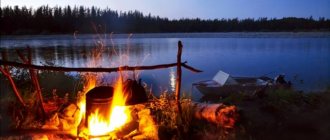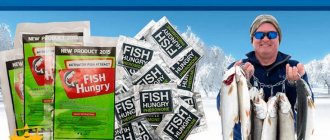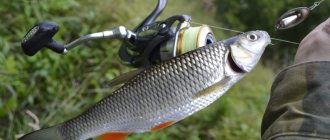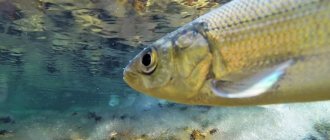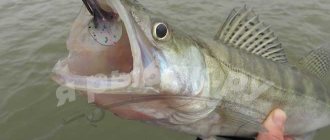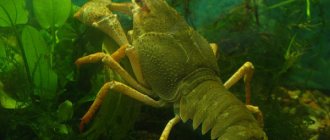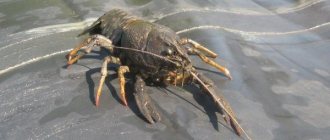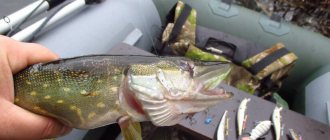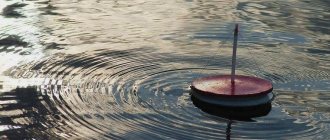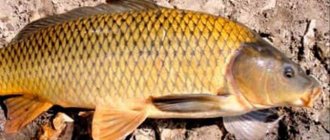Main features of the catch
The total length of the Oka exceeds 1,500 thousand kilometers. In the 60s, the amount of fish was so large that fishing cooperatives caught it. With the construction of industrial enterprises and the development of water transport, the population began to slowly decline.
Today in the river you can find the following types of fish:
- zander,
- perch,
- carp,
- crucian carp,
- ide,
- chub,
- Amur,
- bream,
- carp,
- pike,
- som,
- burbot.
Fishing tactics greatly depend on the bottom topography. Experienced fishermen know that there are a lot of hooks at the bottom of the Oka.
If you choose the wrong gear, you can lose a lot of bait. But even an expensive and high-quality fishing rod does not guarantee a good catch.
Many fishermen say that it is very difficult to find fishing spots on the Oka. Fishing will be successful if you study the behavioral characteristics of different types of fish.
Bream responds well to bait, but it must be applied regularly, otherwise schools of fish will quickly swim to another place.
Most often, representatives of this species can be found in dumps or pits. You can also catch a lot of bream near old structures.
Flocks of ides can be found near the passes. Individuals can be found both in holes and in shallow water.
Roach and silver bream are most often found near the beach area at a depth of about 3 meters.
But if your goal is to catch a big fish, you should pay attention to places with strong currents near the Oka fairway.
Fishing on the river can be successful in places where snags accumulate. Most often there are large holes in which predators hide. That is why there are a lot of fishermen in such places. Many of them are forced to take their seats in the morning. The advantage of such places is that the fish are fed.
Winter fishing on the Oka can be quite successful. In 3 hours you can catch from 2 to 8 kilograms of fish. Missing a catch is a very rare exception. Even during research trips you can catch a lot of small fish.
Features of winter fishing on the Oka River
Fishing on the Oka is the best choice for lovers of a good and noble catch. The subtleties of fishing on this river are passed down from generation to generation, and its popularity is growing more and more. This river gives pleasure to fishermen who hunt for bream and pike.
The Oka has a length of about 1500 m. Its banks differ quite greatly from each other. So, the right one is steeper and higher than the left one.
It’s not strange that predatory fish are found on that side. Oka also has a large number of holes, cliffs, rifts and depressions, which makes fishing, even for a short period, quite varied. Due to the absence of a uniform bottom topography, the river is home to more than 20 species of fish.
Fishing on the Oka allows you to catch perch, asp, burbot, catfish, pike perch, bream, ide, etc.
A little about fishing tacticsGiven the fact that the Oka bottom has a fairly large number of hooks (sandy beaches don’t count), it’s worth finding out in advance what the bottom topography is like in your chosen location. Such information will allow you not only to save a considerable amount of feeder, but also to achieve a better catch.
Good tackle control does not guarantee a good catch. In addition, you need to be able to “read” a body of water, that is, study the habits of different types of fish. It is much easier to catch the desired prey if you know in what places it is “hiding”.
This is what makes fishing on the Oka so different from other places. Kasimov and Serpukhov, in particular, guarantee, with the proper approach, the largest catch of pike perch of considerable size. In general, river fishing tactics have their own characteristics.
For example, bream should be fed on “tables” and dumps interspersed with stones and snags. You should also not avoid bank protection structures, exits from pits and areas near the spring bank behind breaker jets. It is also worth remembering that bream feeds close to the shore, most often under holes.
This should be used when feeding. But bream does not like to wait for a long time, and if the place is not baited for a long time, the fish will leave as quickly as it arrived.
The schooling ide most often stands near the passes. And not only at depth in shallow water, but also in the riffle zone itself. Small roach and silver bream are caught in the beach area and at a depth of up to 3.5 m.
Larger roach are more often and better caught in large concentrations of caddisfly or mayfly. You can often catch it in areas of strong current near the fairway.
Almost all types of fish are partial to all kinds of changes in the bottom topography: slopes, edges, mounds, holes, etc. By feeding in such places, you guarantee yourself that fishing on the river will result in an unforgettable catch with a stable bite.
As for seasonality, fishing on the oka in winter has never been characterized by a lack of bite or catch. Catching 2 kg is the critical minimum of fish caught, but on average the catch reaches 8 kg. Most often, the process itself is fascinating and extremely intense, as it takes about 3 hours. In general, you can only be left without a catch during “research” runs, and even then only in 2 out of 10 cases.
Fishing on the Oka in winter is always a couple of levels more productive than almost any body of standing water. Of the main subtleties, it is worth noting only the question of the weight of the fish. As a rule, if you are hunting for fish heavier than 300 g, then it is better to fish in the current zone. Take a long fishing line (about 20 m) and act.
Fishing on the river, as well as winter fishing on lakes, has its own unspoken laws. For example, you cannot sit close to your neighbor if you are on the same line of wind or current. If these conditions are met, you can sit one and a half meters apart. This is relevant for the reason that fish on the Oka are concentrated in extremely dense streams.
The most favorite fishing places where fishing on the river is possible: Kasimov, Serpukhov, Protvino, Skniga, Nary and others. Have a good catch and remember, a real fisherman is not looking for fish, but for the right place.
Currently, winter spinning is a popular type of fishing, but just 20 years ago only a few people practiced jig fishing in open water in winter. And then mainly in the Moscow River. In addition, the warm winters that have been observed over the past 15 years have contributed to the development of this type of winter fishing.
Why did jig spinning begin to develop in the Moscow River? It is closer to a big city, and there are also many places for convenient fishing from the shore; you don’t need extra ammunition like on the borgs of forest rivers. All that remains is to throw the bait without interference and hope for a quick bite.
Fishing with a spinning rod in open water in winter in Oka
happens differently. In general, there are not so many places for such fishing, unlike the Moscow River. At the same time, you need to prepare yourself for more difficult fishing from a boat.
In terms of the quantity and quality of the catch, winter ice fishing on the Oka cannot be compared with spinning fishing in open water, and of course the score is in favor of the latter.
Since the mid-2000s, winter spinning on the Oka
, gain popularity. Many fishermen from the Moscow River refocused on the Oka. Currently, especially on weekends in winter, in those places where the water on the Oka River remains open, there are simply too many boats.
Winter jig on the Oka
usually begins with November frosts. At this time, the water cools down to +4-5 degrees. It doesn’t bite often, about 2 days a week, but on these days there is a high chance of catching real trophies. At the same time, trophy specimens are caught from year to year on very specific edges and near very specific snags. In this case, the direction of casting, the placement of the boat in the fishing area and the shutter speed are important. Therefore, it is not at all accidental that the largest fish are almost always caught by the same fishermen. They know the river very well, or at least a few excellent points that they have suffered through with their patience.
Large fish migrations occur at the end of November and beginning of December. There are many reasons for this, including the closure of dams when navigation ends and reservoirs that release excess water to winter levels and many other factors. At this time, fish are caught poorly or stop being caught altogether. It all depends on the water level.
Due to such factors, fish located in the lower reaches of the Oka have the opportunity to migrate upstream and use this opportunity. At the same time, the fish located in the upper reaches of the Oka had already taken advantage of this opportunity, migrating to deeper sections of the river in the autumn. Due to economic activity, such sites are mainly located in the Moscow region and mainly near large industrial cities.
Also, the merit of large cities for winter spinning is the discharge of warm waters. And this is crucial for fish nutrition and activity. After all, it’s winter all around.
Spinning fishing in winter in Oka
The most successful is in those places that are closest to the places where warm water drains. Only in very severe frosts can ice form there, but even after the shortest thaw, the ice disappears there and open water appears again.
In mid-February, another large-scale fish migration takes place in the Oka River. The water temperature begins to rise and the fish head to their permanent spawning grounds. The bite on the Oka has been greedy for some time. But then the fish gradually moves to the upper reaches of the Oka and disperses along the tributaries. Therefore, at the end of February and at the beginning of March, fishing with winter spinning rods in Oka
, brings smaller and smaller catches, the bite subsides. And just before the ice breaks up on the Oka River, which usually happens towards the end of March, winter spinning suddenly turns into summer fishing.
The warmest area is the Oka River from the Moskva River to Malivo and a little further. It is very important to have information about the presence or absence of ice. And also about the possibility of travel after a snowfall. As a rule, approaches to the shore are made in Pirochi at the exit from the bay, as well as in Malivo near the mouth of the river.
They fish mainly in relatively deep places, and the most catchy points are located opposite Porichi, as well as opposite the mouth of the stream that flows to Malivo.
Kamenye on the Oka is famous for its riffles; predators are excellently caught there at the beginning of the summer season. About 1 km away, slightly upstream, there is a place where warm water is discharged from the Kashirskaya State District Power Plant. From this place on the section to Bokachi, even in the most severe frosts, Oka is not covered with ice. What is he doing.
winter spinning in Oka
This place is quite popular.
However, during the thaw period, the water near Kashira is somewhat colder than in the Oka near Kolomna by about 2-3 and there are naturally fewer fish then. Unfortunately, such rather large concentrations of large pike perch and pike, which are observed near Kolomna, are not here.
Fishing with a spinning rod in open water on the Oka River, in this place takes place in pits that are located directly under the water discharge. Some holes 2 km from the rift have depths of up to 18 m. The most convenient way to get to the shore is in Kremenye.
In a place called Belomut, the fast flow and narrowing of the river starting from the waterworks to the confluence of the Voblya River makes the ice on this section of the Oka very unreliable. If there are prolonged thaws, the ice in this area is washed away. The most stable areas for winter spinning fishing are located in the pits near the dam.
Moreover, this is one of the few areas of the Oka where there are good places for successful fishing from the shore. To the mouth of the Vobli and to the waterworks there are always well-developed approaches for vehicles.
The Dedinovo-Lovtsy section resembles the meta on the Pirochi-Malivo section, but is located at a greater distance from the Moscow River, therefore it is covered with ice more often. The most interesting areas are those with fantastic bottom topography. There is a road near the shore with ramps into the river.
The Pushcheno area is famous for its trophy predator; it is especially well caught in late autumn just before freeze-up and rising waters. This 1.5 km long section has many promising holes with a depth of 9-14 m. However, it is convenient to reach the shore only from the Luzhki side. The most catchy points are at depths where there is a hard bottom and sharp edges.
Also promising places for open water spinning fishing in the Oka are located in the area of the city of Serpukhov. Near Kashira, from the pits, which are located at the mouth of the Mutenka, a good section stretches to the highway bridge. You can also fish a hole located about a kilometer below the old highway bridge in the area of the left bank. It is also promising to fish from the mouth of the Kashira River to the water intake of the Kashira State District Power Plant.
Near Kolomna, a hole above Osetra and also below Akatevo. Promising pits opposite Bolshaya Kolychevo and pits under the right bank opposite Kolomna.
Winter spinning fishing in the waters of the Oka
, of course, it’s not an easy task, but it’s promising and often delights the spinner with trophy specimens. Recently, winter spinning has become very popular, and the ranks of its adherents are steadily growing.
Happy fishing!
Small rivers during the freeze-up period can bring a lot of pleasure to the fisherman. Winter fishing on the river is significantly different from fishing in still waters. First of all, it involves knowledge of fish sites and periods of their activity. Fishing gear has its own characteristics when used in flowing water.
You can organize a graduation party on the ship 2014 and spend an unforgettable evening. The main trophy on rivers in winter is perch. There is a high probability of catching larger prey - pike, bream, silver bream, roach or pike perch. At such times on the rivers they reach impressive sizes, and it is unlikely that you will be able to find a fish smaller than 100 grams.
The tactics of winter fishing on the river is to constantly search for active prey. Therefore, it is important to equip the gear correctly. Sometimes a few centimeters of fishing line make a decisive difference. To ensure a good catch at great depths, it is worth using a line slightly longer than the depth of the river, because under the hole it bends to the bait and takes the shape of an arc. This way, it will be easier to hear the shocks and touches on the bait and make sure that the chosen place is correct. Experienced fishermen advise not to neglect this factor and use a fishing line of the appropriate length. When winter fishing on the river, you should consider the method of presenting the bait. It is served to the “very nose” of the fish, thereby provoking it to bite. Compliance with this rule guarantees a more successful catch, especially in places with active fish.
So that the fish does not remain indifferent to the bait, it is directed so that it is positioned as naturally as possible. Observing the direction of the river will help determine the strength of the current, and thus it will not be difficult to imagine its movement. Of course, the fisherman should not forget that in winter conditions on the river, experience is needed in order to give naturalness to the bait.
Of course, you should not hope that the sight of bloodworms or maggots swimming against the current or crawling along the bottom will leave fish indifferent. Such actions will scare her and there will be no result from such fishing. To direct the bait in the desired direction, it is evenly lowered to the bottom and carefully moved to the side along the river flow.
It is necessary to take short pauses between movements of the bait, this will to some extent provoke the fish to bite. Of course, the effectiveness of this method largely depends on the chosen gear, but in any case, they are not much different from summer gear.
Fishing on the Oka River in winter 2021 has arrived. My friend and I decided to go to the Oka with an overnight stay for two days. We left at three in the morning and were already in place by eight in the morning. The journey, of course, is not close, but the fish is calling and we responded to this call. Having arrived, we immediately began setting up the girders, after which we started fishing with balance beams, but alas, that’s where the fairy tale ended, and my friend and I did not see a single bite that day, either on the girders or on the balance beams. Evening came, it got dark, and we went to our camp. We lit a fire, warmed ourselves up, drank some tea and went to bed in our jeep. I had to warm up the car several times during the night, but that’s okay, everything is fine, although it’s uncomfortable to sleep in a car in winter. Morning has come. We went out onto the ice with the hope of catching a fish after all... The traps were completely silent, it was a shock, really, this had never happened here before, not a single one worked in two days! Then it was decided to focus on fishing with balance beams. And they did not let us down, although we had to search for and torture the fish for a very long time, forcing it to attack our baits, it really didn’t want this... But we achieved our goal, the fish was caught!
Yes, I will remember these two days for a long time, such an extreme event has not happened for a long time, and the weather tested our strength, but we managed! Oka 2017 Fishing with balance beams.
Oka 2021 Fishing with balancers2017-01-07T14:07:16+03:00
Sources:
- fb.ru
- fishers.spb.ru
- www.inforybaku.ru
- gdekluet.ru
Free fishing on the Oka
There are many places for free fishing in the Serpukhov region. A good catch is ensured near the rifts and sand bars. The following places are considered the most popular:
- The settlement of Lanshino is famous among fishermen for the abundance of asp, perch and ide. Most often, fishing is done using a spinning rod.
- The village of Protvino attracts lovers of perch, pike perch and asp.
- The confluence of the Nora River with the Oka is suitable for catching pike perch and pike perch.
- The bridge near the village of Zibrovo attracts bream lovers.
In the Stupino district of the Moscow region, fishing is quite active.
The section of the river in the area of the Belopesotsky Monastery is popular among fishermen. There you can catch both peaceful fish and predators. Fans of spinning most often install gear in the area of the railway bridge. Opposite the city of Kashira there is a popular cool place. It is very easy to find, since it is located next to the telephone cable laying indicator. The downside of the place is its humidity. Even in summer it is difficult to get there.
In the Lukhovitsky district of the region there is the popular village of Beloomut. It is located near the waterworks on the right bank of the river. Local residents know what kind of fish is found there, as they often vacation there.
In summer you have to occupy convenient areas very early in the morning.
This is due to the fact that the shore is covered with bushes and it is quite difficult to find a convenient approach to the water.
Most often, pike perch become the prey of fishermen.
There are so many of them that some anglers release too small specimens.
Pike and perch are much less common.
Bream lovers can try their luck in the Kolomna area. The village of Bolshoye Kolychevo is located there. Bream are caught using feeders and bottom gear. Some fishermen return home with a catch of perch and ide, but they are much more difficult to find.
The most catchable places
There are many excellent fishing spots on the Oka River, where you can not only see a large number of bites, but also compete with a worthy trophy.
Kasimov
Kasimov is a small town in the Ryazan region, located on the very banks of the Oka. Most anglers come here to catch a variety of white fish. From May to October the fish bite well in these places:
- roach;
- ide;
- chub;
- bream.
These representatives of the carp family are caught mainly with feeder gear, which works better in strong current conditions. Below Kasimov there are good places for fishing for predators. Here you can often meet fishermen from Moscow and the Moscow region.
Dugna
Fishing places are located at the confluence of the Dugna River with the Oka. On this site there is a pontoon crossing, thanks to which you can move to the other side. Many fishermen come here to catch trophy bream.
On a note! A fairly strong current forces the use of heavy feeder gear. The minimum weight of the feeder used must be at least 80 g.
The equipment is cast 40–60 m from the shore, where the nearest channel edge passes. The most promising areas on the Dugna are located next to the bridge.
Nizhny Novgorod
Sport fishing competitions are often held on the Oka River in the Nizhny Novgorod region. There are excellent fishing spots where you can catch both whitefish and predators. The most promising points include:
- water intake;
- beach on Fucik street;
- plot at:
- water area near the Karpov Church;
- plot in the South microdistrict.
Fans of feeder and spinning rods often come to these places on the Oka River. Trophy specimens are found infrequently, since all points are located within the city.
Beloomut
In the Beloomut area you can always meet fishermen, which is explained by the complex bottom topography in this section of the reservoir. Sharp changes in depth attract many different fish here.
Using a watercraft will greatly simplify the search for fish and increase the chances of success.
Feeders and floaters catch large roach, silver bream and bream. Spinning anglers often manage to catch hefty perch and pike perch. Before you go fishing in the Beloomut region, you should study the local depth map in detail.
Paid fishing bases
There are many recreation centers in the Moscow region for fishing in winter and summer. They are very popular among residents of the region. So, very close to the oxygen resort of the region is Drakino Island. There is a recreation center of the same name located there. Very often fishing enthusiasts from the Rusfishing club come there. On the territory of the recreation center there are comfortable cottages where you can stay for several days. Another advantage of the base is the opportunity to relax with the whole family.
The reservoirs are regularly stocked with fry, so even beginners are guaranteed a catch. There are professional instructors at the base who can help you choose the necessary gear. They will help you catch carp or trout. Fishing is allowed both from the shore and from special bridges. There are no catch standards, but each kilogram must be paid upon departure.
The ponds near Serpukhov, located near the village of Arneevo, are deservedly popular among local residents and fishermen from Moscow. There you can have great fishing and relaxation. The list of fish species that are found in the pond is quite large.
The following species can be caught there:
There are certain restrictions regarding fishing.
Each fisherman can use no more than 2 gear. The price of the tour includes catching 4 kilograms of any fish. If the fisherman is luckier, he will have to pay for each additional kilogram.
The recreation center "Otradnoye", which is located near the village of Turovo, attracts fishermen with excellent conditions. There are 3 large ponds inhabited by carp, crucian carp and trout. When purchasing a ticket, you are allowed to catch 5 kilograms of carp or crucian carp.
The trout catch rate is slightly lower, it is 4 kilograms. The base is located almost 100 kilometers from Moscow, but this does not frighten outdoor enthusiasts. In winter you can warm up in an excellent Russian bathhouse, and in summer you can relax on the shore of a reservoir.
Source
The best places for paid fishing in the Nizhny Novgorod region
In the Nizhny Novgorod region there are many places where you can go for paid fishing. Among them:
“Lake near the Jura” (otherwise - Chaglav Ponds)
These ponds are located in the Kstovsky district. You can get to them as follows: from the Kstov industrial zone you need to get to the village of Chaglava.
Fishermen go here for the following types of fish:
There are several ponds where fishermen prefer fishing rods (for roach and crucian carp) and spinning rods (for pike and perch) as gear.
Fish farm "Zarya"
Located towards the city of Arzamas. There are several small ponds here, each of which has different prices for fishing. So, on ponds with crucian carp you can fish for 100-300 rubles, on carp ponds - from 500 rubles and more.
The number of gear is not limited. Fishermen fish here both with simple fly rods and with feeders.
Paid "Chistye Prudy"
The Chistye Prudy complex, located in the Dalnekonstantinovsky district of the region, includes 5 reservoirs rich in fish of various species:
Reservoir "Chizhkovo"
This pond is located near the village of Afanasevo in the Bogorodsky district. Here you can catch the following types of fish:
Prices start from 300 rubles per person (they may change from year to year, so it is better to check the current price with the administration).
You can fish both from the shore and from a boat, using fishing rod, feeder and donkeys as gear.
In addition to fishing, you can relax here with your family or company on the banks with a birch grove.
Prices and rules
As mentioned above, prices for fishing on paid sites range from 300 rubles and above. Depending on the number of fishing rods, as well as the time of fishing.
The reservoirs of Nizhny Novgorod and the Nizhny Novgorod region will not leave either beginners or experienced fishermen indifferent. Here you can fish on the Volga and Oka rivers, on small rivers, on numerous lakes or paid reservoirs, where a catch is guaranteed.
Ichthyofauna of the upper Oka and its tributaries
Alina Chernikova I live in the Russian city of Orel, located in the upper reaches of the great tributary of the Volga, the Oka River. The Oka River downstream is heavily polluted by the runoff of Orel, Kaluga and many other Russian cities, but especially by the runoff of the gigantic Moscow metropolis and the entire 20 million-strong Moscow-Moscow agglomeration. But above the city of Orlya Oka, it is less susceptible to anthropogenic pollution from sewerage structures of populated areas, as well as livestock complexes, the number of which has sharply decreased significantly in the post-Soviet period (and most of them have closed). However, the Oka above the Orel and most of its tributaries (in particular the Kroma, Itska, Tson, Rybnitsa and Orlik) are highly eutrophicated. In the second half of summer and September, the Oka carries a lot of duckweed down to Orel, all blooming with abundant dark green phytoplankton. Within the boundaries of Orla Oka, the city’s thermal power plant is backed by a dam and throughout the city limits it is a wide, up to 120 meters, quiet-water half-river, half-reservoir. Since the mid-80s, the channel of the Oka within the boundaries of Orel has not been cleared and has become very silted, in some places a meter or more layer of sediment has been deposited, the shallows in the summer are heavily overgrown with yellow egg capsule and other aquatic plants. In the 70-80s, one of the favorite objects of amateur fishing from the shore on the Oka within the boundaries of Orel was the ruff. Ruff was the first fish that I myself caught in my life. Nowadays, ruffe are caught on fishing rods in the silty Oka much less often. The most widespread and numerous fish of the Oka ichthyofauna within the boundaries of Orel in the 60-90s was bream. In the coming 21st century, due to siltation of the Oka riverbed and incompletely studied reasons, the number of bream in the Oka has decreased significantly, but it still remains one of the main objects of the Oka ichthyofauna. One of these not fully understood reasons may be the rampant poachers on the Oka. Another reason may be diseases and (or) parasites of bream. For example, next to the Oka, in its floodplain, half a kilometer away, there is Lake Svetlaya Zhizn, which is the main beach recreation area for the residents of Orel. In 2009, in Lake Svetlaya Zhizn, isolated cases of bream deaths from tapeworms were recorded for the first time, which became widespread there in 2011 and especially in 2012. Throughout the warm season in 2013-2014, near the shores of Svetloya Zhizn, at the surface of the water, large numbers of huge bream with their bellies overflowing with tapeworms were making senseless, slow circles of death. Many of their corpses were eaten on the banks in the mornings and evenings by stray dogs. Along with bream, roach and silver bream also died on this lake; no deaths of fish other than the cyprinid family were observed. Such a massive death of fish from the tapeworm led to a slight decrease in the number of swimmers in the lake and an increase in swimmers in other reservoirs, for example, in the suburban Lake Lavrovskoye, where no fish deaths from the tapeworm epizootic were observed. In the Oka, within the boundaries of Orel, the backbone of the ichthyofauna consists of the already mentioned bream, roach (in the last decade, it has overtaken bream not only in numbers, but also in biomass), silver bream, perch, bleak and the ruffe, which is gradually decreasing in number. Pike and ide are also common, but there are much more of the latter in the Oka, a few kilometers above Orel - near Gatya, Fominki and Alshan, where the most pike and ide places are found. Above the Eagle in the ichthyofauna of the Oka, besides them, the most numerous are the same roach and perch. In the area of Kuznetsov and Saltykov they clearly predominate in the Oka. In deep holes closer to the Eagle, bream is also common, and in the rapids and relatively shallow waters - rhiophilic chub and asp, and even small gudgeon. The chub and, in particular, the gudgeon form the basis of the ichthyofauna and small rivers - tributaries of the Oka. In addition to them, in the small tributaries of the Oka, in places, in areas deeper and with a slower flow, there are numerous roach and perch, in some places - bleak and ruff, and there are also small pike. On the sandy reaches of the small tributaries of the Oka, the most abundant gudgeon is that it loves to swim up to the girls swimming there and with its soft lips pleasantly lightly pinch the skin of their legs, cleansing it of dead cells - a natural, completely free spa treatment! More rare fish of the Oka: carp, silver carp and grass carp (escaped from the ponds), pike perch, silver carp, tench, bitterling and burbot. In the small tributaries of the Oka there are also rudd, dace, char, loach and spiny loach. On the tributaries of the Oka there are many ponds where, along with artificially bred fish species, silver crucian carp is found everywhere. Golden crucian carp is also typical for small overseas ponds, and sleeper sleeper is also common in some places. In larger and deeper non-sea ponds, roach and perch usually predominate. The ichthyofauna of the Oka and its upper tributaries in the post-Soviet period suffered greatly from the activities of poachers, which is explained by the low standard of living and mass unemployment of many residents of Oryol villages, and partly city dwellers. In the fall of 2014, the water level in the Oka within the boundaries of Orel dropped sharply - the river was specially lowered in connection with the beginning of the reconstruction of the dilapidated city embankments of the Oka for the 450th anniversary of the city of Orel. On the shallows of the shallowed Oka, a countless number of broken and whole bottles, old completely rusted cans, bags, condoms, old shoes and all kinds of household garbage were exposed; the bottom in many places was literally teeming with it. It is a pity that many people treat their native river so barbarically and thoughtlessly destroy it.
- Published: 12/05/2015 11:00
- Author: Admin
- Seal
I've been trying to get to Oka for weeks, but everything has always failed. And how you want to go to that rift, catch a chub, maybe you’ll catch a pike.
Saturday, July 14, evening, Sunday seems to be free, Olegdgan called to Protva, but I really want to go to the Oka. Oleg will forgive me, but he decided that on Sunday I was going to the Oka.
Sunday, July 15, getting up at 2 a.m., light breakfast, things packed in the evening, although they are always ready. I start from Maly at 2:30. I leave for Kievka and it starts to rain. I’m driving and thinking, should I turn around and go home, get some sleep, or should I go to the Oka? I decide to go to Oka, but they didn’t promise heavy rain in the morning, maybe the rain will stop. The closer we get to Kaluga, the stronger the rain, and it’s crazy... I escaped, and then...
I’m approaching Kaluga, they sparkle
niya, but not home, well, even if the rain is not sugar, I won’t melt. Here is the river bank, it’s as if there was no rain. It would be better if I didn’t say this to myself; I just parked the car and it began to rain. I’m sitting in the car waiting for the rain to end, but I’m thinking: if it rains for a long time, I won’t be able to get back out without a tractor. I turn around and reach the gravel. There’s crushed stone, it’s dark all around, I turn off the road and…. hit. I go out and look. The front left wheel is hanging in the hole, the left side of the car is sitting on its belly, I didn’t see this hole behind the grass, it’s still dark at 3 hours 30 minutes. Well, what a day today is!
He gave up on everything, took the spinning bait, closed the car and went to the river. Then, during the day I’ll pull it out, but now I still can’t see anything.
The river greeted me with silence and murmur. The bottom of the riffle has changed dramatically. At first I decided to fish in last year’s places, at the beginning of the riffle. An hour of gushing water yielded nothing. Not even pokes.
Is there really no chub? I decided to break through the entire roll using an alloy wobbler. I floated the wobbler until the braid ran out. I do the wiring neatly and slowly. In the middle of the roll, a powerful blow. I didn’t have time to hook it, I only managed to work the clutch. Yeah, that means today the chub is standing lower on the riffle. I go downstream a little. I begin to select a wobbler based on depth, casting range, and play. The choice fell on Yuzurik 44. That’s where it began. But on the Uzurik, the tees need to be changed. 15:5 in favor of the chub. Lots of bites, powerful or just pokes.
I did the wiring very, very slowly, casting at 45 degrees with the current. Due to the slow retrieve, the wobbler is carried to the shore. That is, it turns out that the wobbler does not go against the flow, but as if from the middle of the river to the shore.
At 9 o'clock in the morning a small chub entered the riffle, so I finished fishing and went to pull out the car. A shovel, a jack, a board and a car are free. This is how my fishing turned out.
contentmap_plugin
- Back
- Forward
Instructions
- River perch
This fish belongs to the type of freshwater perch and is predatory. The perch's diet includes other freshwater fish that are an order of magnitude smaller than itself. These fish go to spawn in early spring. Previously, it was believed that, along with the rivers of Europe (Oka, Volga, Ural, Danube, etc.) and the rivers of Northern Asia (Ob, Irtysh, Lena, Yenisei, etc.), river perch inhabits the waters of North America, but this is not entirely true. The fact is that there is an independent species of this fish - yellow perch. River perch is a popular game fish. Common roach
Other subspecies of this fish are ram, roach, soroga, chebak. It belongs to the carp family, to the order Cyprinidae. Roach is found in reservoirs of Europe (Oka, Ural, etc.), in lakes and rivers of Siberia (Ob, Yenisei), as well as in the basins of the Aral and Caspian seas. Ichthyologists distinguish many different subspecies of this fish. Some of them are completely freshwater (for example, common roach). The subspecies of roach such as ram and roach are in greatest commercial demand. Bream
Bream is a lake and river commercial fish that lives in schools. The body of the bream is flattened and wide. This fish grows very slowly, gaining half a kilogram mass only by the age of 6 years. Bream is perfectly caught using shell meat, worms, hard-cooked semolina porridge, etc. In rivers (for example, in the Ob), this fish is found in pits, as well as in places with moderate currents, in creeks. Bream is a very valuable commercial fish. Zander
This fish is a relative of the perch, since it belongs to the same family - the perch. In Russia there are only two species of this fish - common pike perch and Volga pike perch. Pike perch meat is lean and juicy, for which it has received high culinary praise. Avid fishermen prefer to fry, boil or stew the fish they catch. In addition, pike perch meat is widely used for preparing various dietary fish dishes. Ruff
This fish also belongs to the perch family. The ruffe is a freshwater inhabitant that inhabits the rivers of Europe (Oka, Volga, Danube) and Northern Asia (Irtysh, Yenisei, Ob). The ruff prefers gravel or sandy bottom. The length of an adult does not exceed 10 cm. The diet of ruffes includes bottom-dwelling invertebrate animals, as well as small fish and plants. In turn, the ruffe is one of the links in the food chain, i.e. catching larger fish.
Source
Endangered species of aquatic biological resources in the Oka River
The Oka is a lowland river and ranks seventh among the rivers of Eastern Europe. The river originates in the Central Russian Upland and flows into the Volga River. Oka remains one of the most popular fishing spots. However, recently such valuable fish species as beluga, white fish and sturgeon have practically disappeared. At the beginning of the 20th century, more than one ton of valuable fish species were caught in the river.
Today, the Oka River is home to three dozen species of fish. More than half of the fish population consists of bream and roach. Also found in the river are perch, ruffe, pike, silver bream, pike perch, and crucian carp. Due to large water pollution and the destruction of fish spawning grounds, the number of fish in the river is decreasing. In the lower reaches of the river there are asp, catfish, ide and chub. As a source we use the scientific article “The Impact of Economic Activities on the Ecosystem of the Oka River” – chail.iteb.serpukhov.su/scch/History_Oka.htm
Fishing on the Oka in the Serpukhov region
The Oka is considered one of the largest rivers in the Moscow region. Here it is especially deep and also wide. In the Moscow region, the river is distinguished by the presence of shallows, riffles and great depths, which makes fishing the most interesting. Quite recently there were quite a lot of fish in the river, which cannot be said about today. With the development of industry and other areas of human activity, the situation with the population of many fish species has noticeably worsened. If earlier it was considered an untouched corner of nature, now this cannot be said.
Now, just look, motor boats or speedboats are rushing along the river surface, both in search of places to relax and the best places for fishing. All kinds of holiday homes, camping grounds and tourist centers are built along the banks of the river. But, despite this, you can still find fishing spots here and have successful fishing. The fish haven't stopped biting yet, so you can always count on a catch. Those who prefer outdoor recreation can appreciate all the delights of such fishing.
Fishing areas on the Oka River in the Serpukhov region
As mentioned above, there are still places on this river where real fishermen can “relax their souls.” Such places are considered:
- Limits of the city of Serpukhov.
- The area of the Lopaski River, or rather the place where it flows into the Oka.
- Limits of the city of Kashira.
- Limits of the city of Ozyory.
- Malyushina Dacha area.
- Limits of the city of Kolomna.
What places should you look for?
To choose a good place for fishing, you should follow some rules. For example:
- It is better to choose areas where there is no fast current and no undercurrents or funnels.
- You should pay attention to the nature of the bottom. The most successful places have a clean, level bottom strewn with small stones.
- The depths of the sections are also of significant importance. Where there is continuous shallow water, you should not count on good fish.
As for winter fishing, there are certain nuances when searching for fish sites. For example:
- You need to look for holes, that is, the deepest places, since the fish go to the holes for the winter.
- The main bait is a worm, maggot or bloodworm. At this time, fish do not bite on baits of plant origin.
- When going winter fishing, you should think about how to dress warmly and how to provide yourself with a warm lunch or just a warm drink.
On the Oka River you can find a place for fishing at any time of the year. People usually take tents, boats, etc. with them when fishing in order to fish comfortably. At the same time, there are many options when you can go fishing and relax in comfort without additional fishing equipment. To prevent the fisherman from carrying around a bunch of sometimes unnecessary things, there are special recreation centers on the banks of the Oka. In addition, in the Serpukhov region there are a sufficient number of paid reservoirs, where the catch is always guaranteed.
Good fishing spots are located near the city of Kashira, where there are many quarries. There are plenty of fish here, such as pike, pike perch and perch.
Paid places
Paid fishing spots are characterized by the following conditions:
- At recreation centers or within a paid reservoir, you can stay in a house or cottage, which allows you to spend as much time as you like fishing.
- Here, as a rule, they offer food, rental of all equipment and a parking space for a car.
- Here, the catch is almost guaranteed, since the reservoirs are regularly stocked with fish.
Free places
In this case, undeveloped places may turn out to be no worse than equipped ones, both in terms of recreation and in terms of fishing. All you need to do is take with you everything you need for a comfortable stay and find a suitable place. There are even camping sites organized by fishermen and vacationers. Moreover, the fee here for services is purely symbolic.
Reservoirs of the Kashira district of the Moscow region
One large river flows through the territory of the Kashira district - the Oka. There are about a dozen small rivers and a large number of unnamed streams. There are no large reservoirs, but there are dams on almost every river. Many reservoirs are flooded ravines.
Oka
Of the 1,498 km of total length, 175 km flow within the Moscow region. On the Kashira lands, the Oka moves in a full-flowing stream. The northwestern border of the district runs along its wide floodplain. In some places the width reaches 250 m. The length of the Kashira bridge across the water artery is 580 m. On the fairway there are depths of up to 10 m, although in most parts of the Oka it is shallow: 1–2 m. The current is fast - 0.5 m/s. Stormy streams wash away the banks, forming intricate terraces. The riverbed is winding, with many rocky rifts and reaches. The ichthyofauna includes more than 20 species. For recreational fishing, perch, pike perch, and pike are of interest. Lots of rudd, chub, silver bream and roach. There are asp, ide and burbot.
Mutenka
The length is 17 km. The source is located in the city of Ozherelye, the mouth is near the village of Lida at 932 kilometers of the Oka River. The river valley is narrow, deeply incised. The shores are mostly bare. The Mutenka flows through a densely populated area, crosses railroad tracks and four highways. In such conditions, only crucian carp survives successfully. Only in the immediate vicinity of the Oka River is the fish population diverse. In the sand pits near the mouth of the Mutenka there are bream, perch, and pike. There are burbots and catfishes.
Besputa
Right tributary of the Oka. It flows along the western border of the Kashira district in a picturesque valley. The length is 75 km, but only the last 7 km are located within the Moscow region. The riverbed winds in an intricate ribbon. On the rocky rifts the water is crystal clear. The banks are covered with dense vegetation. In some places, the branches of bushes and trees on different banks close together, forming a green tunnel. The average depth is 3 m. Closer to the Oka, the channel widens, and many deep holes appear. During high water, Besputa is used for tourist rafting. Typical representatives of the Oka basin are found in Besput: perch, asp, roach, pike.
Bolshaya Smedova
The watercourse crosses the southeastern part of the Kashira district of the Moscow region. The total length is 74 km. The source is located in the Tula region, the mouth is within the city of Ozyory (Ozersky District). The Kashira section is about 30 km. The width of the channel is from 5 to 70 m. The banks are high (up to 8 m), steep, covered with willow thickets. The average depth is 2m. There are deep pools and countless underground springs. Main fish species: perch, chub, pike, ide.
Promising places on reservoirs for fishing
- Oka in the area of the confluence of the Mutenka. Between two bridges in the area of the Belolesotsky Monastery there is a large area (6–8 km), where both peaceful fish and predators that live in the Oka are caught. Bottom fishing prevails in the warm season, when bream are actively biting. Donners and feeders stand in boats on riverbed pits or are located along the shore. Feeders up to 100 g are used, since the current is average. From August to October, spinners flock here. Pike perch and pike are caught with jigs on edges and dumps. Sometimes the trophy becomes a catfish. Perch is found at medium depths. They catch it more often on a retractable leash, using 2-3 inch classic twisters.
- Oka at the confluence with Bolshaya Smedova. The place is popular among spinners, feeders, and floaters. Main fishing objects: perch, chub, asp, burbot, pike perch, roach, silver bream. Perch and chub bite from June to October. Popular baits are small spinners and cranks. It is better to go for zander and pike with the onset of autumn. These predators are most often caught using a jig and a retractable leash. The current of the Oka in the area is not so fast, so baits up to 30 g are suitable. 3-4 inch edible rubber has good results. Asp activity is observed mainly in summer. It is caught on sbirulino, devons and spoon baits.
- Oka in Kashira. On the right bank there is a promising riffle where jig fishing using foam rubber flourishes. The prey of spinning anglers are perch and asp. On the left bank, a promising fishing spot is located in the area of a sand spit. Along the entire length of the river to the railway bridge, pike perch can be caught on remote edges. They get it with long-range spinning rods.
- Oka near the village Flint. In the rolling area, chubs, pike perch, asps, and ides are caught.
- Mutenka near the village of Zendikovo. The dam blocking the riverbed is inhabited by crucian carp, carp, and roach. They are caught using a float and a donk.
- Ponds in Kipelovo. They are attracted by the abundance of crucian carp and rotan. Local fishermen only use chatterbait on their hook. Semolina dough is prepared right on the shore by pouring in water from the pond.
- Ponds in Zavalje. Two reservoirs with a maximum depth of 4 m. Quiet areas alternate with rapids. There are pikes, chubs, and asps. But more often there are perches in the cage. The most effective bait is a spinner.
- Lake Chicherinka. Located near the railway station on the outskirts of Kashira. The maximum depth is 6 m. Due to the lush coastal and aquatic vegetation, people fish from a boat. The lake communicates with the Oka, from where carp, ide, pike perch and even catfish come in in the spring. The catches often contain crayfish, roach, crucian carp, and tench. There are pike, but they are rarely caught. Gear: float rod and spinning rod.
What kind of fish is found in the Oka River
This river is home to many different species of fish, the main ones being:
- Cyprinids such as carp, crucian carp, grass carp, bream, chub, carp, rudd, tench, roach, barbel and ide.
- Perches such as pike perch and perch.
- Representative of cod, burbot.
- Representative of the catfish, som.
- Pike.
- Cancers.
Naturally, this is not a complete list, since other types of fish are also found, but somewhat less frequently.
When is the best time to fish on the Oka?
When going fishing, you need to know when the fish bite on the Oka is most active, based on the time of year. You can start in the spring, when the summer fishing season opens. During this period, there is an increase in fish biting. This is due to several reasons:
- With the arrival of spring, the fish begins to prepare for spawning, so it actively moves around the reservoir, entering small rivers flowing into the Oka. Therefore, the tributaries of the Oka River may turn out to be the most catchy.
- Hungry after wintering, the fish are actively looking for something to profit from. She needs to regain her strength in order to spawn in a timely manner.
As a rule, fish look for shallow waters for spawning, where the water warms up much faster. Fish can also be found in places where currents wash food out of the coastal zone. In such places, fish gather in schools, so fishing can be interesting.
When going fishing, you need to be prepared for the fact that a fairly large specimen may bite.
After the end of spawning, with the arrival of summer, the fish tries to hide from the heat by swimming to depths or other hard-to-reach places. The bite becomes moderate, and in order to catch fish, you need to swim to the middle of the river, where there is depth.
With the arrival of autumn, pike and pike perch begin to become active. This is explained by the fact that the fish begins to prepare for winter and tries to stock up on nutrients.
Features of open water and ice fishing on the Oka
Be that as it may, there are differences between fishing in summer and winter; the only thing that connects fishing within these two seasons is certain types of fish that are active throughout the calendar year.
Fishing for peaceful fish
It is recommended to catch peaceful fish at night or early in the morning, especially when it comes to the summer season. In the spring, when spawning begins, the fish are most active, the catch can be very substantial, but do not forget that fishing will be “banned” at this time, so fishing will only be possible with special gear.
In addition, lovers of this specific hobby are advised to:
- It is advisable to catch white (peaceful) fish in channels and estuaries, where they usually rest;
- When the Oka water becomes clearer (in the morning, early winter), it is recommended to fish from a boat, since according to rumor, fishermen who do this will be able to come home with an excellent catch.
Catching a predator
The highest activity of predatory fish on the Oka is observed in late summer and autumn. Most often, pike and pike perch are caught on the hook, but this does not mean that you cannot catch, for example, burbot.
How to catch more fish?
Here, a lot depends on the region, because the river flows in seven regions, where the level of activity of certain types of fish is different.
When catching predatory fish on the Oka, you should know:
- It is best to catch a predator using a spinning rod, and you can also use some “tricks”;
- Fishing can be organized both on the banks of the river and at its very epicenter - from a boat;
- The best place for fishing for pike and pike perch is considered to be coastal stripes, the depth of which is not lower than 3 meters;
